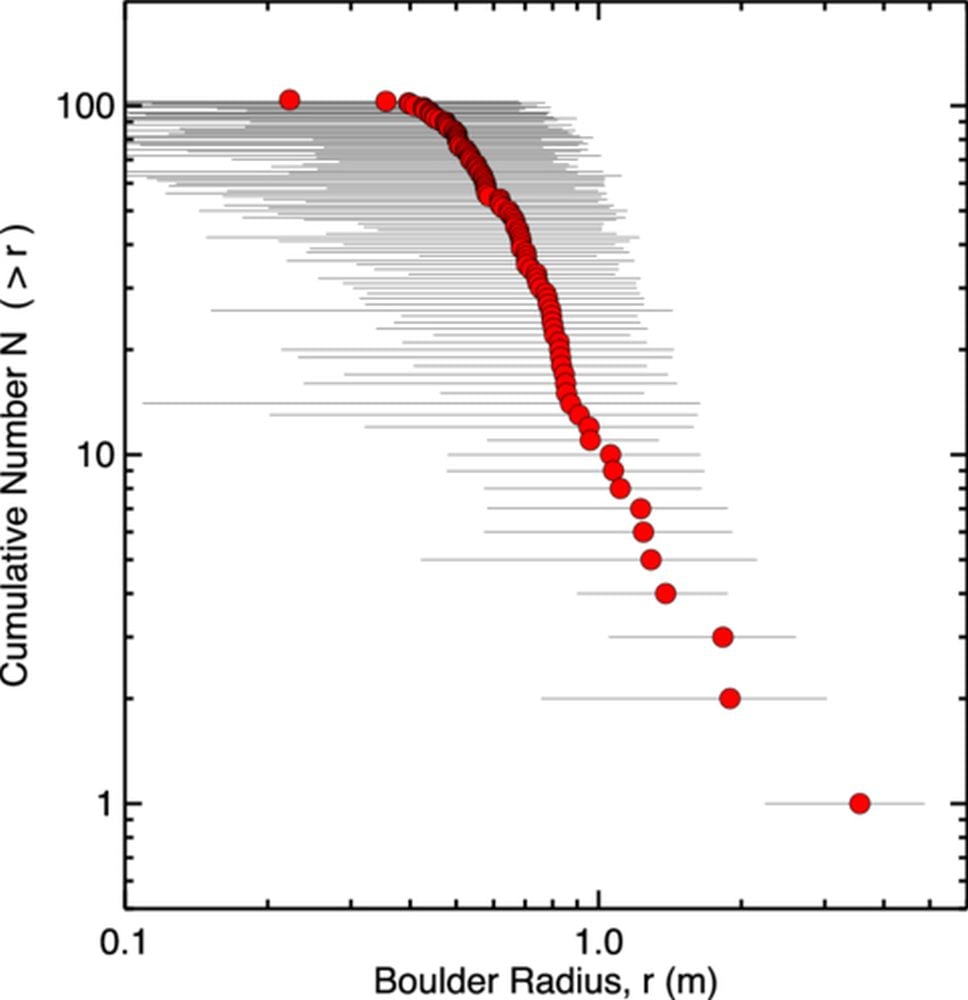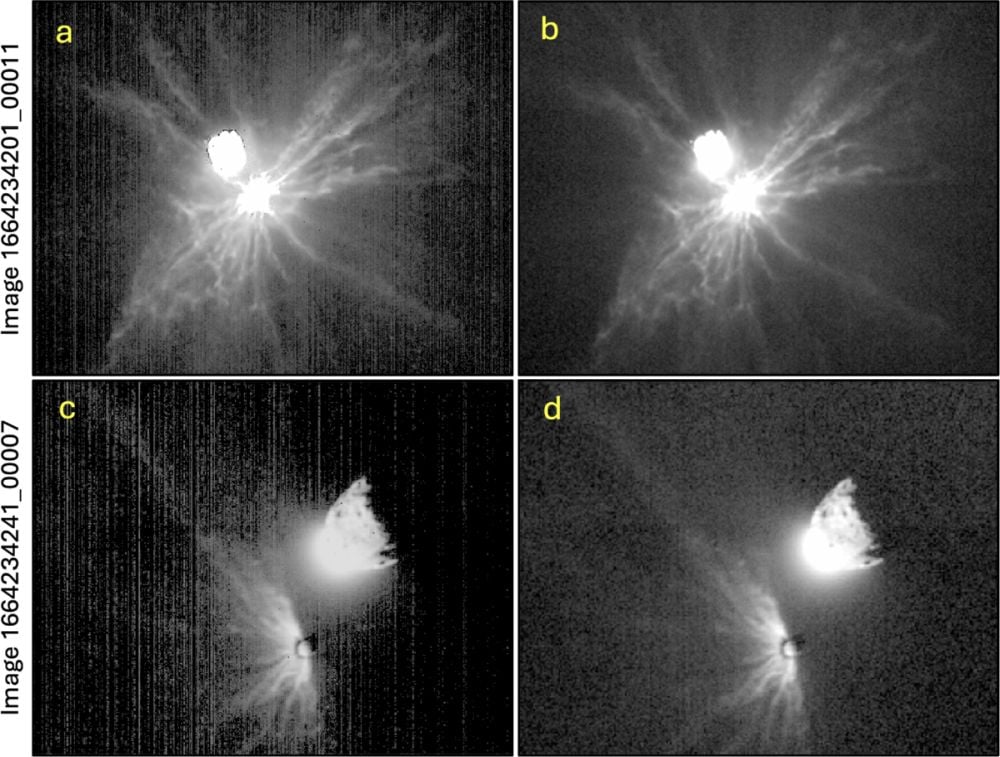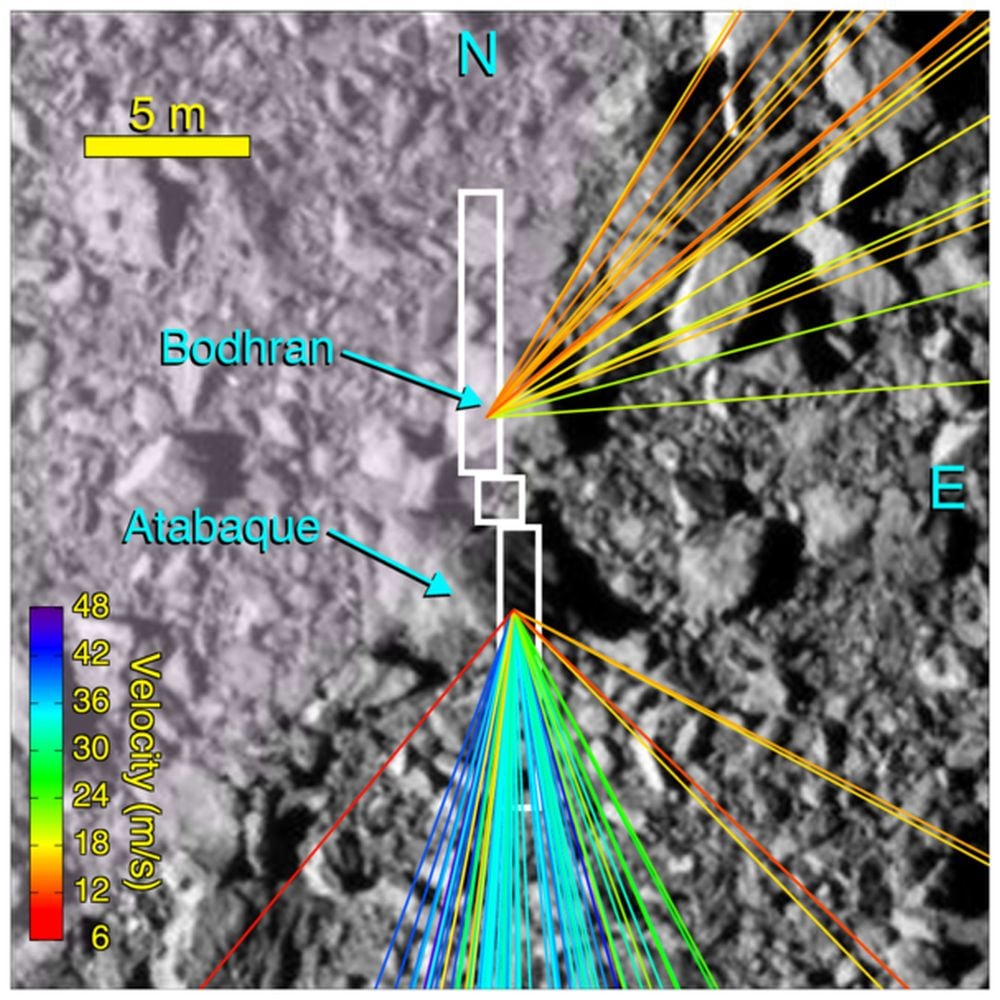We know that there are many asteroids in the Solar System that pose a potential threat. We're getting better at detecting them, and every few months we learn of another one on a potential course to strike Earth. It's obviously in our best self-preservation interest to detect these objects and to figure out how to protect the planet from them. That's what led to NASA's DART (Double-Asteroid Redirection Test).
DART was sent to the double asteroid Didymos and its small moonlet Dimorphos to act as a kinetic impactor. It slammed into the smaller Dimorphos on September 26th, 2022, and then ground-based facilities watched to see the results. The impact shortened Dimorphos' orbit by 32 minutes which constituted a stunning success, since pre-mission success was defined as only a 73 second orbital change.
But in a way, the impact was too successful. This is outlined in a new paper in The Planetary Science Journal titled "High-speed Boulders and the Debris Field in DART Ejecta." The lead author is Tony Farnham, a research scientist at the University of Maryland's Department of Astronomy.
“We succeeded in deflecting an asteroid, moving it from its orbit,” Farnham said in a press release. “Our research shows that while the direct impact of the DART spacecraft caused this change, the boulders ejected gave an additional kick that was almost as big. That additional factor changes the physics we need to consider when planning these types of missions.”
LICIACube (Light Italian Cubesat for Imaging of Asteroids) is a small, 14kg CubeSat supplied by the Italian Space Agency as part of the DART mission. It carried a pair of cameras and was released from DART as the spacecraft sped up for its impact with Dimorphos. As DART impacted Dimorphos, LICIACube took an image every six seconds. It captured images of the impact and its ejecta, as well as images of Didymos' morphology.
LICIACube documented the aftermath of the impact from 29 to 243 s after the impact. The CubeSat images allowed astronomers to track 104 boulders ranging from 0.2 to 3.6 meters in radius. The researchers also estimate an additional 30–40 objects ≤0.5 m that were too dim to track. The 104 boulders sped away from the impact at 52 meters per second (116 miles per hour). Surprisingly, the boulders' paths were not random.
 This figure shows the sizes of the 104 boulders ejected form Dimorphos, with error bars in grey. Image Credit: Farnham et al. 2025. TPSJ
This figure shows the sizes of the 104 boulders ejected form Dimorphos, with error bars in grey. Image Credit: Farnham et al. 2025. TPSJ
“We saw that the boulders weren’t scattered randomly in space,” Farnham said. “Instead, they were clustered in two pretty distinct groups, with an absence of material elsewhere, which means that something unknown is at work here.”
The largest debris cluster contained about 70% of the objects. It was deflected to the south and had high velocities and shallow angles. The researchers think that the boulders in this cluster may have come from a source on Didymos like larger boulders that were blasted into pieces by DART's solar panels as it struck the tiny asteroid.
 This figure shows four images from LICIACube. It compares calibrated images from NASA's Planetary Data System, a long-term archive of NASA mission images, in A and C, with new reduced images from the research in B and D. The new images remove some artificial background structure and makes the ejecta details easier to see. Image Credit: NASA/Farnham et al. 2025. TPSJ
This figure shows four images from LICIACube. It compares calibrated images from NASA's Planetary Data System, a long-term archive of NASA mission images, in A and C, with new reduced images from the research in B and D. The new images remove some artificial background structure and makes the ejecta details easier to see. Image Credit: NASA/Farnham et al. 2025. TPSJ
“DART’s solar panels likely hit two big boulders, called Atabaque and Bodhran, on the asteroid,” explained the paper’s second author, Jessica Sunshine. Sunshine is a professor of astronomy and geology at the University of Maryland. “Evidence suggests that the southern cluster of ejected material is probably made up of fragments from Atabaque, a 3.3-meter-radius boulder.”
 This image is from one of LICIACube's cameras, overlain with Dart and its solar panels shown with white outlines. The pair of boulders struck by the panels are labelled, and coloured lines represent the boulder debris ejected by the impact. Image Credit: Farnham et al. 2025. TPSJ
This image is from one of LICIACube's cameras, overlain with Dart and its solar panels shown with white outlines. The pair of boulders struck by the panels are labelled, and coloured lines represent the boulder debris ejected by the impact. Image Credit: Farnham et al. 2025. TPSJ
"Our analysis of the spatial distribution of 104 of these boulders suggests that they are likely the remnants of larger boulders shattered by the DART spacecraft in the first stages of the impact," the researchers write in their paper. "The amount of momentum contained in these boulders is more than 3 times that of the DART spacecraft, and it is directed primarily to the south, almost perpendicular to the DART trajectory."
 This figure from the research plots the azimuth/elevation angle trajectories derived for the 104 boulders measured by the researchers. It shows their locations in the sky if viewed from the impact site. It shows their velocities and their radii, and clearly shows how the boulders mostly form two distinct groups. Only a few others are scattered in between. The pink are shows the exclusion zone where ejecta would not be seen by LICIACube. The dashed blue line represents the projection of the walls of the dust ejecta cone. Image Credit: Farnham et al. 2025. TPSJ
This figure from the research plots the azimuth/elevation angle trajectories derived for the 104 boulders measured by the researchers. It shows their locations in the sky if viewed from the impact site. It shows their velocities and their radii, and clearly shows how the boulders mostly form two distinct groups. Only a few others are scattered in between. The pink are shows the exclusion zone where ejecta would not be seen by LICIACube. The dashed blue line represents the projection of the walls of the dust ejecta cone. Image Credit: Farnham et al. 2025. TPSJ
The DART mission draws comparisons to NASA's 2005 mission, Deep Impact. Deep Impact was designed to answer fundamental questions about comets. It rendezvoused with the comet Tempel 1 and released a kinetic impactor that impacted the comet's nucleus and excavated a crater.
The comparisons between DART and Deep Impact are all the more relevant because co-author Jessica Sunshine was the deputy principal investigator for Deep Impact. When it comes to defending Earth from impacts, comets are also a hazard, though less numerous than asteroids.
“Deep Impact hit a surface that was essentially very small, uniform particles, so its ejecta was relatively smooth and continuous,” Sunshine explained. “And here, we see that DART hit a surface that was rocky and full of large boulders, resulting in chaotic and filamentary structures in its ejecta patterns. Comparing these two missions side-by-side gives us this insight into how different types of celestial bodies respond to impacts, which is crucial to ensuring that a planetary defense mission is successful.”
The team calculated that the 104 boulders carried a total kinetic energy equaling about 1.4% of the energy of the DART spacecraft. Most of that energy was directed to the south. "With 96% of the momentum from the boulders directed to the south, it is also likely that Dimorphos’ s orbital plane inclination was changed by the impact," the authors write. "These boulders also represent significant momentum contributions that were not accounted for in the orbital period measurements," they explain. Accounting for all of this energy means that the measurement originally obtained in the DART experiment need to be updated. The energy of the boulders likely led to a slight inclination of Dimorphos orbit relative to Didymos equator.
The results also reveal more about what to expect when impactors are sent to collide with rubble-pile asteroids. "These results, along with the filamentary structures in the ejecta cone, will provide unique insights into the physics regarding impacts into rubble-pile asteroids, where material on and under the surface can have important implications for the temporal and spatial evolution of the ejecta," the authors write in their research.
If scientists had to rely only on ground-base observations of the DART impact, they never would've learned about the boulder ejecta. LICIACube provided important information about the variable in planning future asteroid impact missions. (The Hubble Space Telescope spotted 37 boulders from the DART impact but it's observations weren't as detailed as LICIACube's.)
LICIACube isn't the only mission to study the impact aftermath from the DART mission. The ESA's Hera mission is on its way to investigate the impact in more detail.
“Data gathered from LICIACube provides additional perspectives on impact events, especially as DART was originally designed to solely rely on Earth-based observations,” Farnham said. “Hera will do the same by giving us another direct view of the impact’s aftermath, relying on the predictions we’ve made using data gathered from DART.”
Asteroid deflection works every time in books and movies, but in reality, there are a lot more variables.
“If an asteroid was tumbling toward us, and we knew we had to move it a specific amount to prevent it from hitting Earth, then all these subtleties become very, very important,” Sunshine added. “You can think of it as a cosmic pool game. We might miss the pocket if we don’t consider all the variables.”
In their paper's conclusion, the researchers explain that a full accounting of momentum in all directions and an understanding of what role surface boulders played will help them understand how a kinetic impactor affects an asteroid. "Finally, the contributions from the boulder momentum suggest that Hera may encounter a Didymos system in which Dimorphos is tumbling in an orbit that has a slight inclination to Didymos’ s equator," they conclude.

